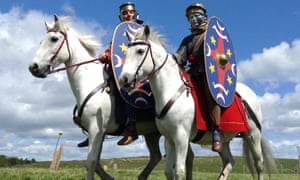Spectacular cavalry battles are to be restaged as part of an ambitious six-month exhibition

Next year, between April and September, the world’s largest-ever re-enactment of Roman cavalry battles will take place along Hadrian’s Wall. The war games will form part of an ambitious six-month exhibition, Hadrian and His Cavalry, bringing together treasures from worldwide public and private collections that have been lent to 10 museums and heritage sites along the wall. These will include the magnificent cavalry helmets and richly ornate armour that made Hadrian’s equestrian troops an awe-inspiring sight.
Organisers hope to challenge the assumption that foot soldiers dominated the frontier garrisons and to demonstrate the key role played by the cavalry in projecting the power of Imperial Rome.
Bill Griffiths, head of programmes for Tyne & Wear Archives & Museums and chair of the project steering group, described the cavalry’s armour as “shiny and showy”. “It’s bling. Hadrian’s cavalry was a showy part of the army, more highly decorated than the infantry’s equipment. Think of the horseguards [today]. It’s very much in that vein of looking the part.”
Dr Jon Coulston of the University of St Andrews, a leading academic on military equipment and the Roman army, said: “The objects are to die for – visually gorgeous. The Roman army is probably the sexiest area of Roman archaeology as far the public is concerned.”
As emperor between AD117 and 138, Hadrian focused his energy on consolidating the empire, strengthening the frontiers’ defence rather than pursuing further conquests. On a visit to Britain in 122, he ordered the construction of the coast-to-coast defensive barrier that became one of Britain’s most famous landmarks. His wall, made of stone and turf was up to 4m tall and 3m thick, with watchtowers every third of a mile, and spanned 73 miles from Wallsend (Segedunum) on the Tyne in the east, to Bowness on the Solway Firth in the west.
A series of forts along the wall, half a day’s march apart, could house up to 1,000 men. Wooden tablets recovered from Vindolanda, a frontline fort, record details of daily life and the practicalities of keeping the “wretched little Britons” in order. One soldier received a package from home with a note: “I have sent you … socks … two pairs of sandals and two pairs of underpants.”
The cavalry was well-fed, dining on venison and oysters washed down with beer and wine. An excavation at Segedunum discovered that cavalry horses were stabled next to the troopers in customised barrack blocks.
The re-enactment will be based on eulogies from Hadrian himself and from Arrian, the governor of Cappadocia, in modern Turkey. In one speech, Hadrian said of his cavalry: “You shot stones from slings and fought with javelins; everywhere you jumped nimbly on to your horses.”
Arrian wrote: “From the helmets hang plumes of yellow hair, not for any practical purpose but to make a fine show. When the horses charge, if there happens to be even a slight breeze, they present a splendid spectacle.” He described training exercises in which horsemen hurled javelins at “target” teams of men and horses in protective armour.
While re-enactment societies are increasing in popularity worldwide, with various companies in India manufacturing Roman military equipment, there is a serious academic side to these exercises, said Coulston.
“It’s not boys and their toys. It’s about technology, economy, metallurgy, culture, art history. Most of the showy stuff was practical. It made them distinctive on the battlefield. If they did something brave, they would be instantly recognised and get military decorations. That was all part of the ethos of achievement and attainment.” Their bravery was often recorded on their gravestones.
The re-enactments will also provide unique insights into the training and tactics of the Roman cavalry, such as the design of cavalry saddles, which enabled cavalrymen to lean out to the side with a long sword or spear or to shoot in any direction with a bow.
Griffiths said: “This is a great archaeological experiment, and fun.”
Coulston spoke to the Observer ahead of a major Roman military equipment conference, entitled Cavalry in the Roman World, which takes place this June in St Andrews. Archaeologists, military historians and classicists are among around 50 speakers. There will also be a small re-enactment, with armoured cavalry and horse-archery displays.
• This article was amended on 11 April 2016 to remove a reference to Roman infantrymen as toga-clad.

Δεν υπάρχουν σχόλια:
Δημοσίευση σχολίου